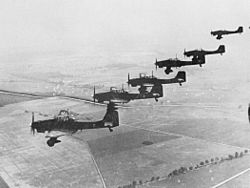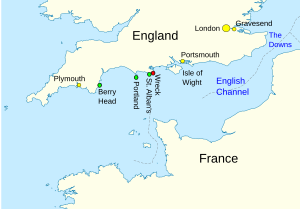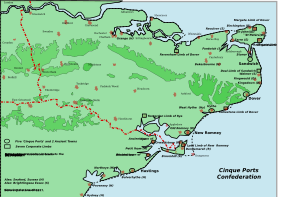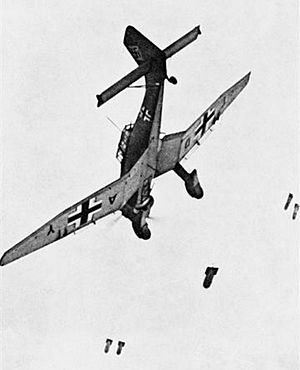Convoy OA 178
Quick facts for kids Convoy OA 178 |
|||||||
|---|---|---|---|---|---|---|---|
| Part of World War II | |||||||
 Formation of Ju 87 Stuka dive-bombers (photographed over Poland in 1939) |
|||||||
|
|||||||
| Belligerents | |||||||
| Commanders and leaders | |||||||
| Oskar Dinort (StG 2) Carl-Heinz Birnbacher (S 24) |
F. J. G. Jones (Clarkia, escort commander) B. G. Scufield (Broke) R. P. Galer (convoy commodore) A. B. Fasting (vice convoy commodore) |
||||||
| Strength | |||||||
| 26 Junkers 87 Stuka dive-bombers of III./StG51 24 Ju 87s of I./StG2 4 S-boote of 1.SFlotille |
1 corvette, 1 destroyer 14 ocean-going merchant ships plus coasters |
||||||
| Casualties and losses | |||||||
| 1 Ju 87 shot down, 2 crew killed 1 Ju 87 crashed, 2 crew rescued 1 Bf 109 damaged on landing |
Convoy: 5 ships sunk 11 damaged 5 damaged in harbour |
||||||
Convoy OA 178 was a group of ships traveling together for safety during World War II. This particular convoy, called "Outbound Atlantic 178," included 14 large ships and many smaller ones, making a total of 53 vessels. It started its journey from Southend-on-Sea in England on July 3, 1940. The convoy sailed through the English Channel and was supposed to break up on July 6, with its ships joining other convoys heading across the Atlantic Ocean.
However, on July 4, German Junkers Ju 87 Stuka dive-bombers attacked Portland Harbour and the convoy itself. Later that night, German fast attack boats, known as Schnellbooten (or E-boats), also attacked the remaining ships. The British Royal Air Force (RAF) did not send fighter planes to protect the convoy. This lack of protection made the Prime Minister, Winston Churchill, very upset. After this event, convoys like OA 178 were rerouted to go north around Scotland to avoid the dangerous English Channel.
Contents
Why were Convoys Attacked?
German Air Attacks on Ships
During World War II, German air attacks on ships became much easier after Germany captured bases in France and other nearby countries. In the North Sea, German planes attacked British fishing boats many times in June 1940. By July, more ships were being sunk by air attacks off the east coast of England than by naval mines.
Attacks on minesweepers (ships that clear mines), escort vessels (ships that protect convoys), and anti-invasion patrols (ships watching for an invasion) increased quickly. This was made worse because the British didn't have enough light anti-aircraft guns. Also, most of their air defense was focused on protecting southeast England from a possible German invasion.
The British Navy allowed ships to fire at any aircraft that seemed to be attacking them. They found that a lot of quick, accurate gunfire could make bombing less accurate and sometimes even shoot down enemy planes. However, because sailors had rushed training and weren't good at recognizing planes, they often fired at friendly RAF aircraft, even when these planes were supposed to be protecting the ships. This caused problems between the Navy and the RAF.
What were OA Convoys?
OA convoys, meaning "Outbound Atlantic," were groups of ships that left the Thames Estuary in England. They traveled together to the Western Approaches, which was a safe area in the Atlantic Ocean. From there, the ships would join other convoys to reach their final destinations across the ocean.
These OA convoys also included smaller ships, called coasters, that traveled along the south coast of England to ports like Southampton and Plymouth. Even after France fell to Germany on June 22, 1940, these convoys continued to sail along the dangerous south coast. For example, on July 1, 1940, Convoy OA 177G sailed with twenty ships. The next morning, German planes attacked one of its ships, the SS Baron Ruthven, killing two men. Later, another large ship, the Aeneas, was bombed and had to be abandoned.
The Convoy's Journey Begins
Convoy OA 178 gathered near Southend-on-Sea. The convoy was led by Lieutenant Commander Frederick Jones on the only escort ship, the corvette HMS Clarkia. The main leader of the merchant ships, R. P. Galer, was on the SS Peterton. The convoy, made up of 14 large merchant ships and local coal ships, left on July 3. German aircraft flew over them, heading inland.
The convoy passed through the Straits of Dover during the night of July 3/4. By dawn, German planes started flying past again. The captain of the ship Hartlepool, W. J. Rogerson, could see the Isle of Wight in the distance. He said the visibility was very clear, about fourteen miles, and he could even see the French coast. By the afternoon of July 4, Convoy OA 178 was south of Portland Bill.
The Attacks of July 4
Attack on Portland Harbour
At 8:41 a.m. on July 4, 33 German Junkers Ju 87 Stuka dive-bombers attacked Portland Harbour. They were protected by other German fighter planes. One of the main targets was HMS Foylebank, an auxiliary anti-aircraft ship. This ship had powerful guns designed to shoot down planes.
When the Stukas attacked, they dove almost straight down towards the ship. At about 1,500 feet, they would level out slightly, aim their guns, and fire. They released their bombs as their machine-gun fire passed beyond the front of the ship. A siren on the plane would blare to tell the pilot to drop the bombs and pull out of the dive. The entire raid lasted only four minutes.
Many sailors on Foylebank were hit by bullets or bomb blasts as they ran to their battle stations. One sailor described bombs hitting the ship, causing huge damage and many casualties. Acting Leading Seaman Jack Mantle was badly wounded in his leg by a bomb but kept firing his gun. He even hit a Stuka plane. Mantle was later helped away from his gun as the ship was being abandoned. He later died from his wounds.
The Stukas dropped 104 bombs, many hitting Foylebank or landing very close. Civilians in small boats came to rescue the survivors from Foylebank. About 60 men were killed immediately, and many more died later from their injuries, including Jack Mantle. German fighter planes flew overhead, but no RAF fighters appeared to help. Two Stukas were shot down by ground fire during the attack. Other ships in Portland Harbour, like the City of Melbourne and William Wilberforce, were also damaged.
Attack on the Convoy at Sea
Soon after the attack on Portland Harbour, a German reconnaissance plane spotted Convoy OA 178 southwest of Portland. More Stuka dive-bombers were sent to attack the convoy.
Around 1:00 p.m., the Stukas attacked the ship Flimstone. The captain watched the planes pull out of their dives very close to his ship, and bombs shook the vessel. The attack lasted about two hours. The escort ship, Clarkia, fired its guns at the Stukas.
The chief officer of the Dutch ship Deucalion later wrote that the sky seemed full of planes. His ship was hit by nine bombs and started to sink. The captain and carpenter were seriously wounded. The crew abandoned the ship when there was a short break in the attack.
The ship Dallas City was also hit by three bombs, wounding two crew members. The already damaged Flimstone tried to avoid Dallas City but crashed into its side, damaging a lifeboat. The crew of Dallas City abandoned their ship, which sank around 5:00 p.m. Its crew was rescued later by the ship Antonio.
The Antonio itself was machine-gunned and nearly hit by bombs, damaging its rudder. It rescued 67 shipwrecked sailors, including 27 from the sunken Deucalion. Other ships, like the Dutch Britsum and the Estonian Kolga, were also sunk by bombers. Many other ships were damaged.
The convoy commander ordered the remaining ships to head for the safety of Portland Harbour. However, the harbour had been attacked that morning, and three merchant ships there were already damaged. The harbour was too small and dangerous for the remaining 40 ships, so they were turned away. Still, no RAF fighter planes appeared to protect the convoy.
Night Attacks by E-boats

Near midnight, German fast attack boats, called E-boats, began their attacks. E-boat S 19 torpedoed the ship Elmcrest south of Portland. The ship started to list, and the crew abandoned it. The E-boat fired another torpedo, which passed under a lifeboat before hitting the ship. The lifeboat capsized, and 16 men drowned. Survivors were rescued by the destroyer HMS Sabre.
Soon after, E-boats S 20 and S 26 hit the tanker British Corporal with two torpedoes. Two crewmen were killed, and the ship was abandoned. It didn't sink immediately and was later towed into port. The ship Hartlepool was also torpedoed by S 26 and abandoned. It was later beached at Weymouth.
The Convoy Disperses
On July 5, the destroyer HMS Broke joined Convoy OA 178 to provide more protection. By July 6, the surviving ships of Convoy OA 178 reached the Southwest Approaches and joined other convoys heading across the Atlantic.
Aftermath and Losses
People Lost
A total of 176 people were killed on HMS Foylebank, including officers and sailors. Another 157 were rescued. Sixteen men from the ship Elmcrest were killed, and one man from the Kolga also died. In total, 193 people were killed during the attacks on Convoy OA 178 and Portland Harbour. One German Stuka crew was shot down and killed by anti-aircraft fire from Foylebank during the attack on Portland Harbour.
Ships in Convoy OA 178
| Name | Flag | GRT | Casualties | Notes |
|---|---|---|---|---|
| Aegeon | Greek | 5,285 | Damaged by air attack 4 July | |
| Alex | UK | 3,932 | ||
| Antonio | UK | 5,225 | Damaged, detached 4 July | |
| Ardanbhan | UK | 4,980 | To Newfoundland | |
| Argos Hill | UK | 7,178 | Damaged, detached to Portland 4 July | |
| Briarwood | UK | 4,019 | Damaged, detached to Weymouth Bay 4 July | |
| British Corporal | UK | 6,972 | Damaged, detached 4 July | |
| British Prince | UK | 4,879 | ||
| Britsum | Netherlands | 5,255 | Sunk by aircraft 4 July | |
| Csarda | Panama | 3,882 | ||
| Dallas City | UK | 4,952 | Sunk by aircraft 4 July | |
| Deucalion | Netherlands | 1,796 | Sunk by aircraft 4 July, 27 survivors | |
| Eastmoor | UK | 5,812 | Damaged by aircraft, detached 4 July | |
| Elax | UK | 7,403 | ||
| Elmcrest | UK | 4,343 | 16 | Sunk by S-boot S 20 4/5 July |
| Elstree Grange | UK | 6,598 | ||
| Eskdalegate | UK | 4,250 | To St John's Newfoundland | |
| Fairwater | UK | 4,108 | Damaged, detached 4 July | |
| Flimston | UK | 4,674 | Damaged, detached to Portland 4 July | |
| Gulhaug | Norway | 1,243 | To Portsmouth | |
| Harbury | UK | 5,081 | ||
| Harpalyce | UK | 5,169 | ||
| Hartlepool | UK | 5,500 | Damaged, beached Weymouth Bay 4 July | |
| Irene Maria | UK | 1,862 | Damaged, detached 4 July | |
| Jaypore | UK | 5,318 | ||
| Kedoe | Netherlands | 3,684 | To New Orleans | |
| King Frederick | UK | 5,106 | Damaged by aircraft, beached Weymouth Bay 4 July | |
| Kolga | Estonia | 3,526 | 1 | Sunk 4/5 July by S 19 |
| Lifland | Denmark | 2,254 | Damaged, detached 4 July | |
| Peterton | UK | 5,221 | ||
| Saluta | UK | 6,261 | ||
| San Ambrosio | UK | 7,410 | ||
| Standella (?) | UK | 6,197 | ||
| Temple Moat | UK | 4,427 | To Buenos Aires | |
| Trefusis | UK | 5,299 | To St John's Newfoundland |
Escort Ships and Anti-Aircraft Ships
| Name | Type | Pennant | Notes |
|---|---|---|---|
| HMS Clarkia | Flower-class corvette | K88 | Escort 3–6 July, joined convoy HX 53 |
| HMS Broke | destroyer leader | D83 | Escort 5–6 July, joined convoy HX 53 |
| HMS Foylebank | Auxiliary anti-aircraft ship | Bombed in Portland Harbour 4 July, sank at mooring 5 July; 176 killed, 157 survivors |
Ships Lost or Damaged in Portland Harbour
| Name | Flag | GRT | Casualties | Notes |
|---|---|---|---|---|
| City of Melbourne | UK | 6,630 | Damaged by near miss from Ju 87 dive-bombers | |
| East Wales | UK | 4,358 | Damaged by Ju 87 dive-bombers | |
| HMS Foylebank | RN | 5.582 | 176 | Bombed by Ju 87s 4 July, sank at moorings 5 July |
| Silverdial | UK | 55 | Sunk by Ju 87 dive-bombers | |
| William Wilberforce | UK | 5,004 | Damaged by Ju 87 dive-bombers |




